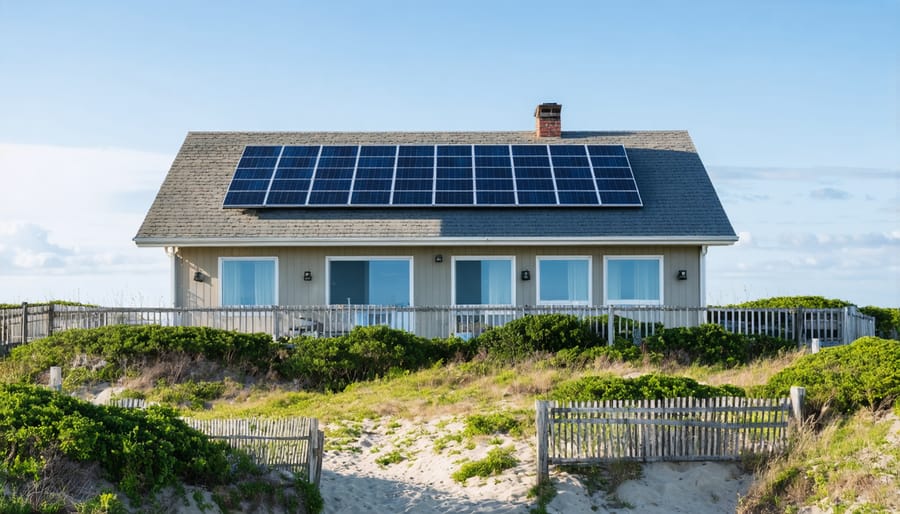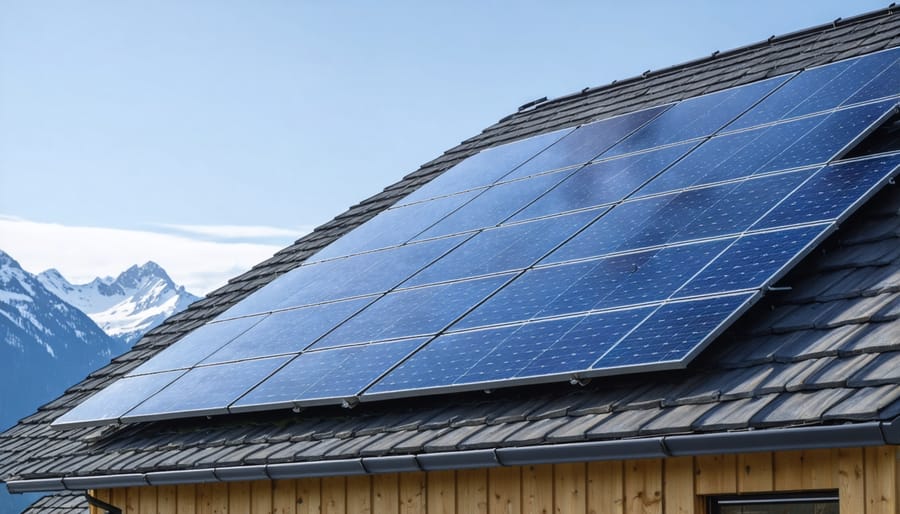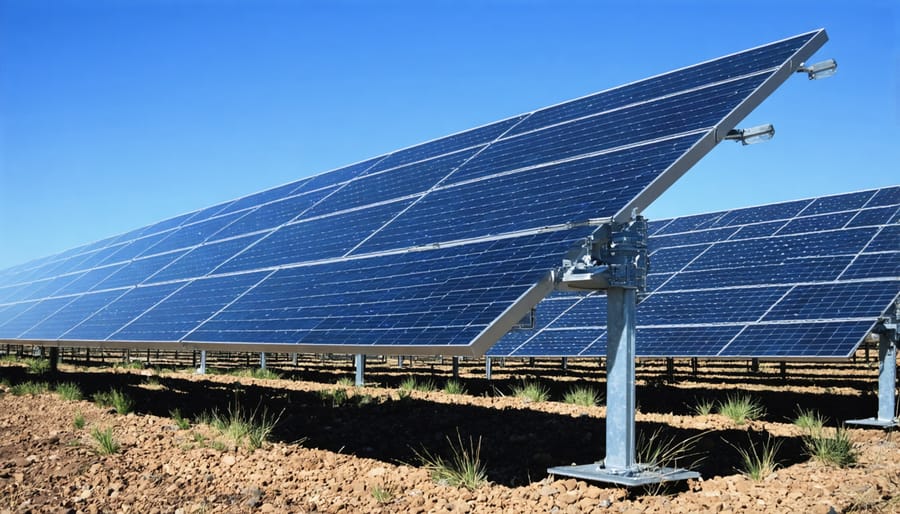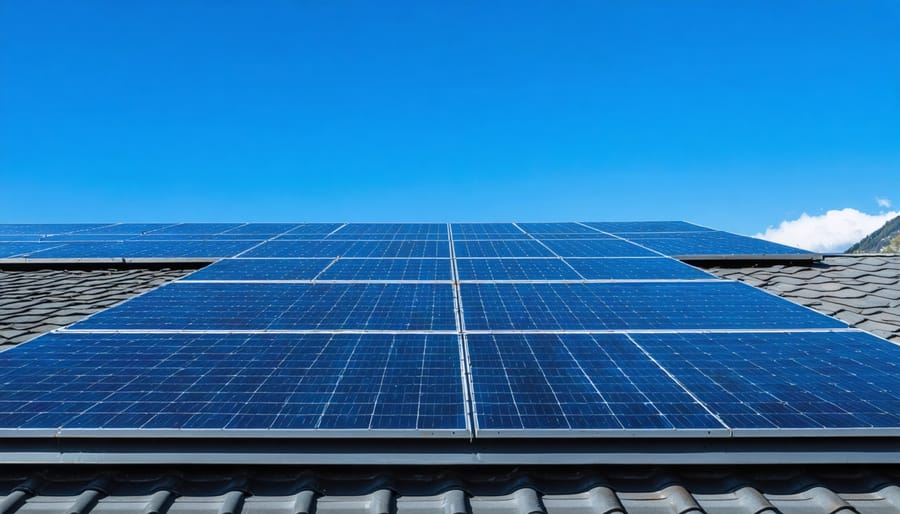Solar energy’s efficiency has evolved dramatically, transforming from a mere 1% conversion rate in the 1950s to today’s cutting-edge panels achieving up to 23% efficiency in real-world conditions. Across British Columbia’s diverse landscapes, from the sunny Okanagan Valley to the coastal regions, solar installations now generate between 1,000 to 1,300 kilowatt-hours annually per installed kilowatt – enough to power the average BC home for 2-3 months. This remarkable advancement in solar technology, coupled with a 70% drop in installation costs over the past decade, has made solar power not just environmentally conscious but economically compelling for homeowners and businesses alike.
While efficiency varies by region and installation quality, modern solar systems can recoup their initial investment within 6-8 years in optimal conditions, providing clean energy for 25+ years. The technology’s effectiveness in BC’s climate challenges common misconceptions about solar viability in cloudy conditions, with advanced photovoltaic cells now capable of generating significant power even during overcast days. As global energy demands rise and climate concerns intensify, solar energy’s increasing efficiency represents a crucial solution for sustainable power generation in our region.
How Location Shapes Solar Panel Performance
Solar Irradiance Across British Columbia
British Columbia’s diverse geography creates varying levels of solar potential across the province. The Okanagan Valley, particularly around Kelowna and Penticton, receives the highest solar irradiance in BC, with approximately 2,000 hours of sunshine annually. This makes it an ideal location to calculate solar panel efficiency and maximize energy production.
The Lower Mainland and Vancouver Island experience moderate solar potential, with approximately 1,600 to 1,800 hours of annual sunshine. Despite frequent cloud cover during winter months, these regions still maintain viable solar energy production, especially during long summer days.
Northern BC communities like Prince George and Fort St. John receive fewer direct sunlight hours but benefit from extended daylight during summer months, which partially compensates for winter limitations. The Interior regions, including Kamloops and Williams Lake, enjoy clear skies and low humidity, creating excellent conditions for solar energy generation.
Coastal areas may experience reduced efficiency due to marine layer fog, but modern solar technology can still effectively harvest diffuse light, making solar installations worthwhile across all BC regions.
Seasonal Variations in Solar Production
In British Columbia, solar energy production follows distinct seasonal patterns that affect overall system efficiency. During summer months, when daylight hours extend up to 16 hours in many parts of the province, solar panels can generate significantly more power than in winter. Vancouver Island and the Lower Mainland typically experience a 60-70% reduction in solar production during December and January compared to peak summer months.
However, this seasonal variation doesn’t mean solar isn’t viable year-round. Modern solar technologies are increasingly efficient at capturing diffuse light, making them effective even on cloudy winter days. The Okanagan region, known for its sunny climate, maintains relatively strong solar production throughout the year, with only a 40-50% winter reduction.
Snow can actually enhance solar production through the “albedo effect,” where sunlight reflects off snow onto panels. Plus, the cooler temperatures in winter help solar panels operate more efficiently, partially offsetting the reduced daylight hours. Many BC homeowners optimize their systems by adjusting panel angles seasonally and implementing smart energy storage solutions to balance these natural fluctuations.
Real-World Solar Performance Data
Coastal vs. Interior Performance
British Columbia’s diverse geography creates interesting variations in solar energy efficiency between coastal and interior regions. While many assume the sunny Okanagan Valley has a clear advantage, the reality is more nuanced. Interior regions like Kelowna and Kamloops do benefit from approximately 15-20% more annual sunshine hours, but coastal areas have their own advantages.
Modern solar panels have become increasingly efficient at solar performance in cloudy conditions, making them viable even in Vancouver and Victoria’s overcast climate. The cooler coastal temperatures actually help solar panels operate more efficiently, as excessive heat can reduce panel performance by up to 25%.
Recent data from BC Hydro shows that coastal installations typically generate 1,000-1,100 kWh per kW of installed capacity annually, while interior systems average 1,200-1,300 kWh. However, coastal systems often perform more consistently throughout the year, while interior systems show greater seasonal variation.
Communities like Salt Spring Island and Powell River are proving that coastal solar can be highly effective, with numerous successful installations achieving payback periods similar to interior regions. The key to maximizing efficiency in both regions lies in proper system design, optimal panel orientation, and regular maintenance to address local environmental factors like coastal salt spray or interior dust accumulation.


Urban vs. Rural Installation Success Stories
In British Columbia, solar energy success stories span both urban and rural settings, showcasing the versatility of solar installations. In downtown Vancouver, the Vancouver Convention Centre’s 2,500-panel installation generates enough power to offset 35% of the building’s energy needs while serving as a model for urban solar integration.
Rural installations tell an equally compelling story. The T’Sou-ke First Nation on Vancouver Island transformed their community through a comprehensive solar initiative, installing panels on community buildings and homes. This project not only reduced energy costs but also created local jobs and energy independence.
In the Okanagan Valley, several wineries have embraced solar power, with installations seamlessly integrated into their agricultural operations. Mission Hill Family Estate Winery’s solar array powers their production facilities while preserving the aesthetic appeal of their grounds.
The Interior region presents unique success stories, like the off-grid homestead near Williams Lake that combines solar panels with battery storage to achieve complete energy independence, even during winter months. Meanwhile, in Victoria’s residential areas, neighborhood solar initiatives have created “solar communities,” where multiple households share installation costs and maximize efficiency through collective planning.
These diverse examples demonstrate that solar energy can thrive in any setting, from dense urban environments to remote rural locations, adapting to different needs and circumstances while delivering consistent benefits to communities across British Columbia.
Maximizing Solar Efficiency in Your Region
Panel Positioning and Angle Optimization
In British Columbia’s diverse landscape, achieving maximum solar efficiency starts with proper panel positioning. The optimal panel orientation typically involves facing panels south at an angle between 30-45 degrees, depending on your specific location within the province.
Coastal regions like Vancouver and Victoria benefit from panels set at a 35-degree tilt, while interior locations such as Kelowna may require slightly steeper angles around 40 degrees to maximize winter sun exposure. During installation, consider factors like roof pitch, surrounding trees, and seasonal sun paths to determine the best positioning for your situation.
Modern mounting systems allow for seasonal adjustments, which can increase energy production by up to 15%. In summer, a flatter angle of 30 degrees captures more sunlight during longer days, while steeper winter angles of 45 degrees help optimize collection during shorter days. Some BC homeowners report energy gains of 20-30% simply by fine-tuning their panel angles throughout the year.
For flat roofs or ground installations, dual-axis tracking systems can boost efficiency by up to 40%, though these systems require more maintenance and initial investment. The key is finding the right balance between optimal positioning and practical constraints for your specific location.
Remember that even slight deviations from ideal angles can still produce significant energy, making solar viable for most BC properties with reasonable sun exposure.

Weather-Smart Installation Strategies
In British Columbia’s diverse climate zones, strategic solar panel installation can significantly boost energy production despite varying weather conditions. Coast Mountain Solar’s data shows that proper positioning can increase efficiency by up to 25% in challenging weather conditions.
For coastal areas like Vancouver and Victoria, installations typically face south at a 30-35 degree angle to maximize exposure during shorter winter days and manage rain runoff effectively. In the Interior regions, where sunshine is more abundant, panels can be installed at slightly lower angles (25-30 degrees) to capture maximum sunlight during longer summer days.
Smart weather-adaptive installations include micro-inverter systems that prevent entire arrays from being affected by partial shade, and snow-shedding features for mountainous regions like the Kootenays. Many BC installers now use split-rail mounting systems that create air flow beneath panels, reducing snow accumulation and improving performance in wet conditions.
Monitoring systems play a crucial role in weather-smart installations. Modern solar setups in BC include real-time performance tracking that allows homeowners to adjust panel angles seasonally. Some systems even feature automated cleaning mechanisms that activate during heavy pollen seasons or after dusty summer days.
These weather-conscious installation strategies have helped BC homeowners maintain consistent energy production throughout the year, with many reporting only a 10-15% variation between summer and winter output levels.
Economic Benefits by Region
Regional Incentive Programs
British Columbia offers numerous incentive programs to make solar energy more accessible and affordable for residents and businesses. The CleanBC Better Homes Program provides rebates of up to $1,000 for residential solar installations, while businesses can access the PST exemption on renewable energy equipment, saving 7% on their initial investment.
In Vancouver and the Lower Mainland, homeowners can benefit from additional municipal incentives, including expedited permit processing and reduced permit fees for solar installations. The City of Vancouver’s Green Buildings Policy also encourages solar adoption through density bonuses and development cost levy reductions.
The Interior regions, including Kelowna and Kamloops, offer unique programs through local utilities. For example, FortisBC provides net metering opportunities, allowing solar system owners to earn credits for excess energy production. These credits can significantly reduce annual electricity costs, especially during peak summer production months.
On Vancouver Island, communities like Victoria and Nanaimo have established innovative financing programs. The Property Assessed Clean Energy (PACE) program enables property owners to finance solar installations through their property taxes, making the investment more manageable over time.
Northern BC residents can access specialized funding through the Northern Development Initiative Trust, which offers enhanced rebates to offset the higher installation costs in remote areas. Additionally, Indigenous communities can apply for specific funding through the First Nations Clean Energy Business Fund.
To maximize these benefits, consider consulting with local solar installers who are familiar with regional programs and can help navigate the application process. Many utilities also offer free energy assessments to help determine the most cost-effective solar solution for your property.
Remember that incentive programs are regularly updated, so it’s advisable to check with your local government and utility providers for the most current offerings.
Long-term Savings Calculator
To help you make informed decisions about solar energy investments in British Columbia, several reliable tools and methods are available for calculating potential savings. The solar panel payback period calculator on our website factors in your specific location, energy consumption patterns, and current electricity rates.
Start by gathering your annual electricity usage from your BC Hydro bills and your roof’s specifications. Our regional solar calculator then considers local factors such as:
– Average daily sunlight hours in your area
– Seasonal weather patterns
– Local installation costs
– Available incentives and rebates
– Current electricity rates
– Projected energy cost increases
For example, a typical Vancouver home using 11,000 kWh annually might save between $1,100 and $1,400 per year with a properly sized solar system. Interior regions like Kelowna often see higher savings due to more annual sunshine hours.
To get the most accurate calculations:
1. Use your actual electricity consumption data
2. Input your roof’s orientation and slope
3. Consider any shade from nearby trees or buildings
4. Account for planned changes in electricity usage
Remember that savings calculations should factor in the BC Step Code requirements and potential increases in electricity demand from electric vehicle charging or heat pump installations. Many homeowners in British Columbia find that their actual savings exceed initial calculations due to rising energy costs and improved system efficiency over time.
For a personalized assessment, our interactive calculator provides detailed projections based on your specific circumstances and location within BC.
Solar energy’s efficiency in British Columbia presents a compelling opportunity for sustainable power generation, despite our region’s unique climate challenges. As we’ve explored throughout this article, modern solar technology can achieve efficiency rates of 15-22% in residential installations, with some premium systems reaching even higher performance levels.
The key takeaway is that solar energy remains a viable and increasingly efficient option for BC residents, particularly in areas like the Okanagan Valley and Vancouver Island, which receive abundant sunlight. Even in coastal regions with more cloud cover, advanced panel technology and proper system optimization can ensure meaningful energy production throughout the year.
Our local success stories demonstrate that solar installations are delivering significant returns on investment, with many homeowners reporting energy bill reductions of 50-70% after switching to solar. The continuous improvements in panel efficiency, combined with provincial incentives and declining installation costs, make now an ideal time to consider solar energy for your property.
We encourage you to take the next step by conducting a solar assessment for your specific location. Local solar providers can help evaluate your property’s potential and design a system that maximizes efficiency based on your roof orientation, local climate patterns, and energy needs. By joining BC’s growing solar community, you’ll not only reduce your carbon footprint but also contribute to our province’s renewable energy future while potentially saving significantly on long-term energy costs.

